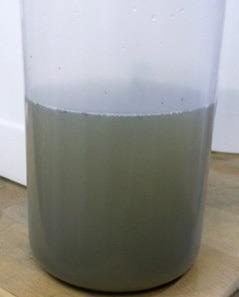Automation During the Concentration of Radionuclides and Heavy Metals in Water Samples
Water is a key resource and represents the primary uptake route (incorporation route) for chemotoxic and radiotoxic substances. For this reason, water constituents are extensively scrutinized, which demands great efforts.
Radionuclides and heavy metals are evaluated in surface and drinking water, groundwater and wastewater, as well as in rainwater, principally as part of nuclear power plant monitoring.
The activity concentrations of the β-emitters tritium, 14C and 90Sr, the β-emitting isotopes of uranium, plutonium, americium and curium and of γ-emitters such as 137Cs or 60Co, are continuously analyzed.
The necessary detection limits required must be frequently concentrated throughout analysis which usually takes place after a radiochemical purification, to prevent interference in the different measuring techniques, whether radiometry, mass spectrometry or some other method.
Radionuclides are also identified in aqueous samples for research purposes. The detection limit requirements tend to be even higher in this case.
Objective: Automating the Concentration of Water Samples Using a Large-Scale Rotary Evaporator with an Automatic Module
Evaporation is an appropriate method for concentrating radionuclides and heavy metals from large volumes of aqueous samples.
Conversely, sorbents or flocculating agents can be utilized, although these are only marginally suitable when numerous radionuclides that are chemically very different such as 137Cs, 90Sr and plutonium isotopes, require simultaneous analysis in a sample.
Another proven process is gentle concentration by evaporation in open vessels, but it is time-intensive for sample volumes greater than a few liters and thus no longer practicable.
Starting at sample volumes of about 10 liters, the use of a largescale rotary evaporator is very efficient.
Another benefit is that simple distillation is sufficient as purification for tritium, which is present in aqueous samples as HTO (tritiated water) and therefore, the distillate amassing in the condenser of a rotary evaporator is directly employed for the following activity measurement (in the case of tritium, utilizing liquid scintillation counting).
Traditional evaporators have the disadvantage that, depending on the volume, the evaporation flask must be manually refilled at relatively short time intervals.
As a result, personnel must be permanently transferred during normal work time, which results in the interruption of other tasks. Outside of operating times, traditional rotary evaporators must be shut down. The evaporation of large volumes of samples is therefore extended considerably.
Using an automated Hei-VAP Industrial large-scale evaporator with the automatic module Distimatic from Heidolph can eliminate the restrictions of conventional rotary evaporators.
The sample concentrate level in the evaporation flask was established via a capacitive fill-level sensor. When the sensor identifies too little media, water is refilled automatically through a PTFE tube from a sample storage tank.
When the storage tank is empty, operation is stopped via detection by the automatic module, which switches off the system. Therefore, the evaporator can also be run overnight. With storage tanks that possess the appropriate dimensions, operations can take place over the weekend.
In the present case, the customer wished to replace the traditional large-scale evaporator setup in use with an automated system in order to enhance efficiency.
Method and Results
Successful automation of rainwater evaporation with 4,6 l/h was achieved. The aim was to evaporate samples of up to 70 liters of rainwater to a quantity of about 1 liter within one day.
Initially, the pH of the rainwater samples was adjusted to pH 1 with nitric acid and pre-filtered with a 63 µm filter before the evaporation process. The test setup is illustrated in Fig. 1.

Figure 1. Hei-VAP Industrial with Distimatic test setup. Image Credit: Heidolph North America
The Distimatic Industrial Platinum 8 Package was utilized for this test. With the recirculation chiller set to 5°C, a rotational speed of 115 rpm and a vacuum value of 30 mbar at 65°C heating bath temperature, a distillation rate of 4,6 l/h could be accomplished. The rainwater concentrate at the end of the process is shown in Fig 2.

Figure 2. Concentrated rainwater. Image Credit: Heidolph North America
The customer’s expectations were met – the volume of sample could even be increased. Around an hour’s worth of work per technician each workday in contrast to conventional rotary evaporators previously used.
Because the device can function overnight, the entire evaporation process is finished within a much shorter time than with a traditional largescale evaporator.
Conclusion: Heidolph’s Distimatic Industrial Platinum 8 Package Meets the Challenge
This example demonstrates that Heidolph products facilitate the automation of rainwater evaporation. The efficiency can be significantly increased by setting up a continuous workflow that operates overnight and on weekends.
All-in-all, the same results can be accomplished with a comparatively small number of personnel within a short time scale in contrast to traditional evaporators with an otherwise identical technical design.

This information has been sourced, reviewed and adapted from materials provided by Heidolph North America.
For more information on this source, please visit Heidolph North America.